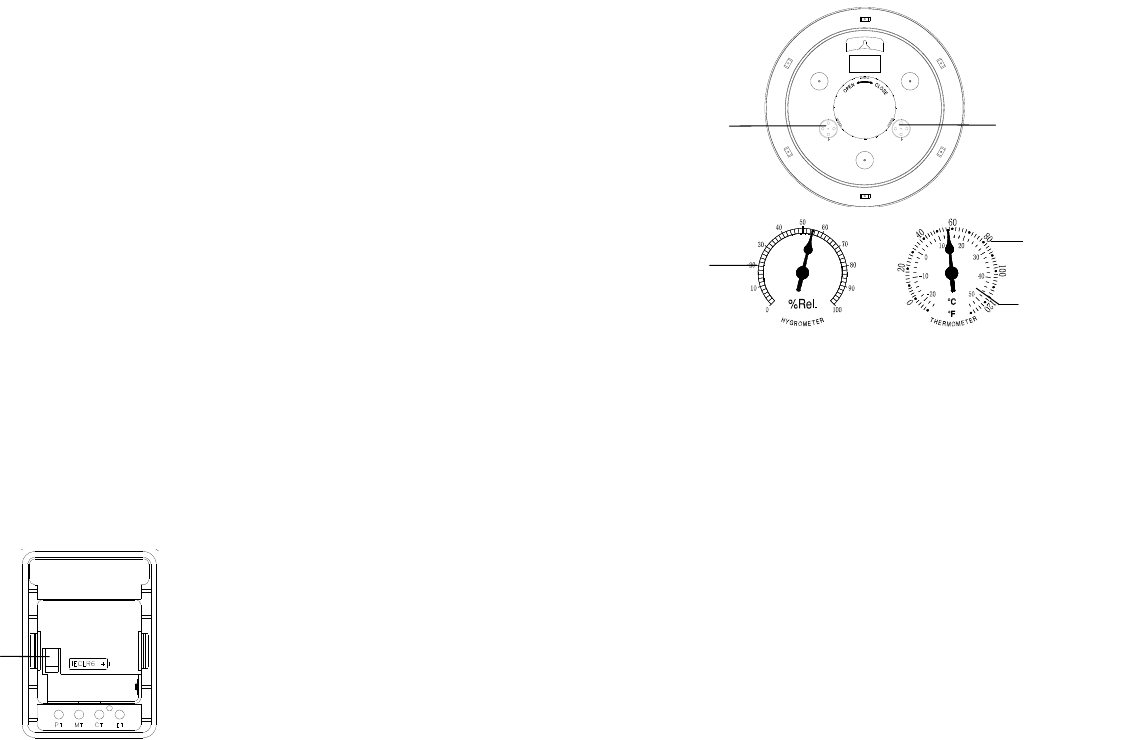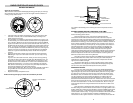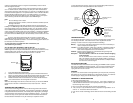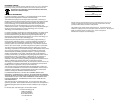
3
continue to periodically search for a signal and automatically reset the hands
when the signal is received.
The La Crosse Technology atomic clock is designed for indoor or outdoor
use. For indoor locations, select a location to place your radio controlled clock
where it will be at least six feet away from a TV, computer, air conditioner or other
household electrical appliances. The optimal location is near a window. Windows
facing Colorado provide the best signal. For outdoor locations, try to select a
location sheltered from direct sunlight and rain, preferably under a roof or porch
area, and facing Colorado for better reception of the WWVB signal.
Note:
• Do not submerge clock in water.
• Extreme temperatures, vibration, and shock should be avoided to prevent
damage to the clock.
The WWVB time signal will easily penetrate masonry and wood framed
buildings. The WWVB signal will penetrate almost every residential building and
most steel buildings if they have adequate windows. It is not possible, however,
for the WWVB signal to penetrate most indoor shopping malls and rooms in the
center of large office buildings that do not have windows. In buildings that WWVB
cannot penetrate you may set the time using the manual time set button. When
the clock receives the WWVB signal it will automatically set the hands to the exact
time.
La Crosse Technology atomic clocks do not receive or process radio
controlled time signals from Germany’s DCF 77, Japan’s J Ga AS, or England’s
MSFs atomically regulated transmitters. La Crosse Technology atomic clocks can
be manually set and used anywhere.
For more information on the NIST and radio controlled time, see
www.boulder.nist.gov/timefreq/
SET THE TIME USING THE MANUAL TIME SET BUTTON
In some cases, the La Crosse Technology atomic clock may not receive the
WWVB signal due to atmospheric disturbances or hard to reach locations such as
inside shopping malls. In this case, please use the Manual Time Set button,
located at the back of the clock to manually set the time. To do this:
1. Press and hold the Manual Set button.
2. Release the Manual Set button and again press and hold the Manual Set
button. The minute and hour hands will fast-forward while the button is held.
3. Keep holding the Manual Set button until the time is set as required.
4. Release the button. About 3 seconds later, the second hands will start to
move and the clock is now running with manual time.
Note:
When the clock displays manual time, it will continue to try to receive the WWVB
signal at each of the even numbered hours: 0:00, 2:00, 4:00, 6:00 … 20:00 &
22:00.
TEMPERATURE AND HUMIDITY
The La Crosse Technology atomic clock has two analog sensors that measure
surrounding temperature and humidity. The temperature information is displayed
in degrees Fahrenheit and Celsius, and humidity data is displayed in percentage.
The thermometer and hygrometer have been calibrated in factory. To check the
sensors accuracy, tune to your local weather forecast information broadcast for
the latest weather information. It may be necessary to adjust the sensors.
MANUAL TIME
SET
4
To manually adjust the sensors, gently turn the corresponding knobs located at
the back of the clock until required data has been reached.
TROUBLESHOOTING
The wonderful advantage of owning a La Crosse Technology atomic clock is that
it is virtually trouble free. If the clock receives a clear signal it will set itself
perfectly. If it does not receive a signal consider the following:
Battery - The La Crosse Technology atomic clock must have a fresh battery to
receive and process the time signal.
Location - Try a different location, ideally near a window. It should be at least six
feet from computers, TVs, air conditioners, other atomic clocks and
other electrical appliances that cause interference.
Weather - Electrical storms between you and Colorado during the night will
interfere with the WWVB signal.
Reception - The clock seems to “take off” for no reason and then stopping
at the same time.
It is not uncommon for the clock to make a "correction", sometimes
daily. This happens if the clock gets ahead of itself by a fraction of
a second. To correct this the clock will advance a complete rotation
the next time it receives a signal.
DAYLIGHT SAVING TIME
The National Institute of Standards and Technology and WWVB encode a special
DST “bit” in the WWVB transmission for DST. Your La Crosse Technology clock
will read this information and automatically advance the hands one hour in the
spring and eleven hours in the fall.
ARIZONA
If you live in an area that does not recognize DST you must press the (unmarked)
DST button for one second to deactivate your clock’s DST program. To reactivate
the DST program simply press the DST button again for one second.
FREQUENTLY ASKED QUESTIONS
Q. How long will the battery last?
A. A good AA alkaline battery will last over one year. If your clock is located in an
area with little interference where it can quickly receive a signal the battery can
last much longer than one year.
Q. Can a La Crosse Technology atomic clock be used outdoors?
A. Yes, but only in a dry environment and in a temperature range between -10 °F
and 131 °F. The clock is NOT water-resistant.
Q. Can the La Crosse Technology atomic clock be wired to control timing circuits?
A. No.
Outer ring displays
temperature in
degree Fahrenheit
Inner ring
displays
temperature in
degree Celsius
Humidit
y
display in %
Calibration
knob for
thermometer
Calibration knob fo
r
hygrometer





